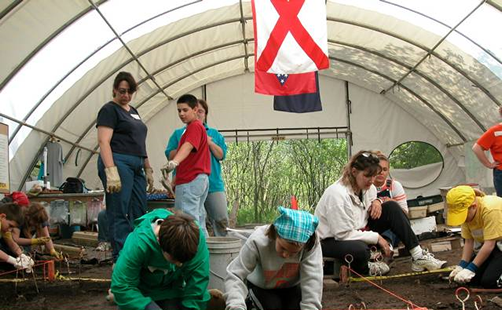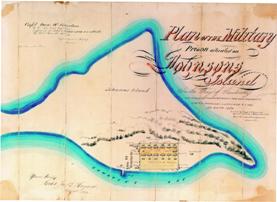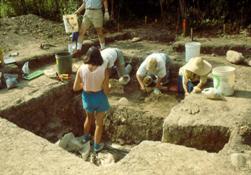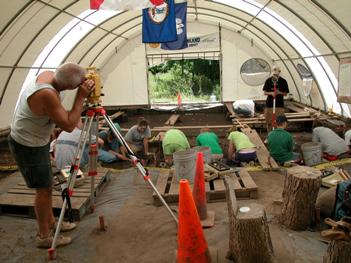|
Field Research |
| Results from the
2005 season, along with plans for 2006 |
|
Field Specimens |
|
Archives |
| Data and photos
from previous digs, including images of some of the
thousands of artifacts collected at the site |
| |
|
POW Research |
| Resources and
information for those conducting genealogical and
other research into the officers incarcerated in the
prison |
| |
|
|
|
|
Research

Since the spring of 1989, Dr. David
Bush has directed investigations at Johnson's Island.
Currently, the archaeological
research at Johnson's Island will consist of only analysis
of those cultural materials which have been recovered. No
additional field work is planned. The Experiential Learning
Program in Historical Archaeology will also not be running
at this time.
We have left the discussions of our former field and
laboratory research efforts on the website in order to give
those that wanted to know what we did the ability to see our
work.
As a result of both
historical documentation and field research, the prison
stockade, Fort Johnson, the remains of Fort Hill, and the
dock have been located. Archaeological excavations have been
carried out in several sinks (latrines) dating from 1862 to
1865, a prison well, the powder magazine from Fort Hill, and
portions of two prison blocks Archaeological remains from
these features have provided much information on the human
condition within the prison yard as well as the personal
possessions of the inmates. The 2004 summer field school in
archaeology focused on excavations of the 1862 latrine from
Block 4, a regular prisoner housing block. We also
discovered one of the 1865 latrines.
 The initial goals of the study of
the Johnson's Island Civil War Military Prison site were to
determine the boundaries of the site and what types of
archaeological remains exist. The initial goals of the study of
the Johnson's Island Civil War Military Prison site were to
determine the boundaries of the site and what types of
archaeological remains exist.
This was necessary due to
proposed development of the island. Through an effort to
understand the historical importance of the site, an effort
was made to locate some of the writings from both the Union
and the Confederate Officers imprisoned on the island as
well as reviewing all that had been written about this
prison site. In 1990, it was determined that there was both
a wealth of historical documentation about Johnsonís Island
prison, and that there was also an archaeological resource
that remains unparalleled for any other American Civil War
Prison site. For these reasons, the Johnsonís Island Civil
War Military Prison site was selected as a National Historic
Landmark property.
In 1864, the Union expanded
the prison compound from 14.5 acres to 16.5 acres, moving
the western fence approximately 100 feet further to the
west. At the same time, the Union excavated a ditch to
bedrock around the three inland stockade walls of the prison
to prevent prisoners from attempting escape through
tunneling. This ditch served as the most definitive
archaeological feature for defining the boundaries of the
prison compound. Our initial investigations in 1989 and 1990
were to locate this ditch on all sides, allowing a precise
determination of the prison compound.
 When the ditch was finally
located, the next phase of research involved locating some
of the sinks (latrines) associated with several of the
prisoner Blocks (housing units). Each Block had a latrine
located behind it, and these latrines were used for short
periods of time, filled in, and new ones dug. Eventually,
each Block had five or more latrines to their rear. It was
important that we document the condition of these latrines,
as well as ground truthing some of the historical mapping
that existed allowing us to have a full understanding of the
prison compound layout. Our investigations in 1990 through
1996 were aimed at locating and testing latrines associated
with Blocks 1, 6 (the prison hospital), and 8. In all, ten
latrines were located, with five being completely excavated
and three others being sampled. When the ditch was finally
located, the next phase of research involved locating some
of the sinks (latrines) associated with several of the
prisoner Blocks (housing units). Each Block had a latrine
located behind it, and these latrines were used for short
periods of time, filled in, and new ones dug. Eventually,
each Block had five or more latrines to their rear. It was
important that we document the condition of these latrines,
as well as ground truthing some of the historical mapping
that existed allowing us to have a full understanding of the
prison compound layout. Our investigations in 1990 through
1996 were aimed at locating and testing latrines associated
with Blocks 1, 6 (the prison hospital), and 8. In all, ten
latrines were located, with five being completely excavated
and three others being sampled.
These studies of the
latrines have given us a partial view of the changing
treatment of POWs throughout the Civil War. We have a better
understanding of the medical treatment of the POWs, and we
also have documented prisoners attempts to escape through
tunneling. Several publications have been produced through
these studies and more are certainly on the way.
These studies have also
enabled researchers to see what types of materials were
available to the prisoners. This is not something that has
been well understood historically, and now for the first
time can be clearly documented from the Civil War. The
materials recovered from the study of the latrines, as well
as our study of the prison Blocks themselves, have shown
that the prisoners had at times access to a variety as well
as vast quantities of materials.
 Since 1997, our focus has
been on the investigation of the locations where the prison
Blocks were located. The past two summers have been spent
investigating Block 2, a general housing block. We have
recovered a wealth of information about the day to day
existence of the prisoners based on the small pieces of
material that fell through the cracks of the floor of that
block. For the most part, these materials are located in the
plow zone. After the prison was abandoned and the buildings
removed, Mr. Johnson continued to use the prison compound
for agricultural purposes. Aerial photographs from 1939
through the 1950s show the prison compound being plowed. The
plow zone is excavated, screened, and all historic materials
recovered. The subsoil underneath the plow zone has provided
evidence of the posts used to support the structure, as well
as drainage ditches and possible pits used to hide
contraband materials. Since 1997, our focus has
been on the investigation of the locations where the prison
Blocks were located. The past two summers have been spent
investigating Block 2, a general housing block. We have
recovered a wealth of information about the day to day
existence of the prisoners based on the small pieces of
material that fell through the cracks of the floor of that
block. For the most part, these materials are located in the
plow zone. After the prison was abandoned and the buildings
removed, Mr. Johnson continued to use the prison compound
for agricultural purposes. Aerial photographs from 1939
through the 1950s show the prison compound being plowed. The
plow zone is excavated, screened, and all historic materials
recovered. The subsoil underneath the plow zone has provided
evidence of the posts used to support the structure, as well
as drainage ditches and possible pits used to hide
contraband materials.
The archaeological
resources of Johnsonís Island are certainly unique. Nowhere
else does there exist time capsules (in the form of
latrines) from the American Civil War, giving us a few
months at a time of how prisoners were treated. Nowhere else
does there exist such a wealth of primary documents, giving
us a day to day account of how these prisoners saw their
predicament. Combined, this provides the best field
laboratory for demonstrating not only the science of
archaeology, but also a chapter of American history as seen
through prisoners of war.
|